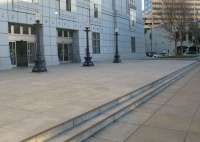A proposal for the entrance of the San Francisco Public Library based on the Principle of Least Effort (George Kingsley Zipf, 1949)
Transit/Stasis
As I emerged from the BART station, I was taken with the sight of a commuter who opted to walk up the broken escalator with a cone in front of it rather than take the stairs. I contemplated the thought process… perhaps he was hoping it would engage, elevating him effortlessly to street level. I began observing how often people chose their mode of transport according to the “Principle of Least Effort”. This theory, published by Harvard linguist George Kingsley Zipf in 1949, was developed in regards to library and information sciences and it remains relevant today. It has since been applied to many aspects of human behavior. In its broadest interpretation, it postulates that humans, animals and even machines will choose the path of least resistance. Within the library sciences this equates to finding information quickly and easily. In human behavior, while this has often been used metaphorically, we have begun to practice this literally in our day-to-day lives. The statistics on obesity reinforce this, as do my own casual, visual observations during commute hours. I have often wondered how long someone has waited for the bus only to ride it two blocks.
Perhaps this path of least resistance is the first step toward making the body obsolete. Spiritual enlightenment strives to leave bodily suffering behind. The car, the bus, the escalator, and the Internet have all become prostheses towards this end. Or are they? Are we making things easier or harder on ourselves in the long run? Removing the functionality of the escalator brought this into question.
My proposal is to install a non-functional, two-step escalator in front of the San Francisco Public Library’s (Main Branch) Larkin Street entrance and in doing so call into question one’s chosen path toward enlightenment. The library serves as the symbol of this enlightenment in a secular, western philosophical sense. Will reason prevail?
A proposal for the entrance of the San Francisco Public Library based on the Principle of Least Effort (George Kingsley Zipf, 1949)
Transit/Stasis
As I emerged from the BART station, I was taken with the sight of a commuter who opted to walk up the broken escalator with a cone in front of it rather than take the stairs. I contemplated the thought process… perhaps he was hoping it would engage, elevating him effortlessly to street level. I began observing how often people chose their mode of transport according to the “Principle of Least Effort”. This theory, published by Harvard linguist George Kingsley Zipf in 1949, was developed in regards to library and information sciences and it remains relevant today. It has since been applied to many aspects of human behavior. In its broadest interpretation, it postulates that humans, animals and even machines will choose the path of least resistance. Within the library sciences this equates to finding information quickly and easily. In human behavior, while this has often been used metaphorically, we have begun to practice this literally in our day-to-day lives. The statistics on obesity reinforce this, as do my own casual, visual observations during commute hours. I have often wondered how long someone has waited for the bus only to ride it two blocks.
Perhaps this path of least resistance is the first step toward making the body obsolete. Spiritual enlightenment strives to leave bodily suffering behind. The car, the bus, the escalator, and the Internet have all become prostheses towards this end. Or are they? Are we making things easier or harder on ourselves in the long run? Removing the functionality of the escalator brought this into question.
My proposal is to install a non-functional, two-step escalator in front of the San Francisco Public Library’s (Main Branch) Larkin Street entrance and in doing so call into question one’s chosen path toward enlightenment. The library serves as the symbol of this enlightenment in a secular, western philosophical sense. Will reason prevail?

